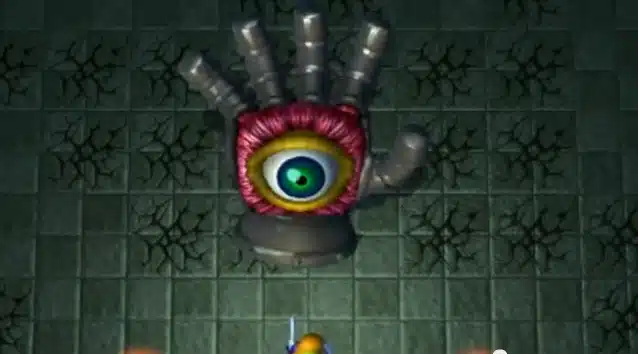Back in 2013, Nintendo was in a difficult position — this was after the glory days of the Wii and DS, and before the hybrid joy of the Nintendo Switch. The Wii U was floundering in 2013, and the humble 3DS was selling okay numbers, as it was the system many Nintendo fans put most of their time into. Gamers, Nintendo fans, and people generally were going through different stages of life, but for me, having just left university and wondering about what to do with my life, it was a time when the 3DS offered joy and escapism.
In November 2013, a new Zelda game was released for the 3DS. The Legend of Zelda: A Link Between Worlds used the same game world as the SNES classic — The Legend of Zelda: A Link to the Past. However, the game had a completely new 3D art style, the gameplay was much more responsive, and it had a new story. More than that, the game attempted innovative, more “free” gameplay ideas, and in retrospect, this made the game an influential title. A Link Between Worlds could be described as a new expansion or sequel to A Link to the Past. In honor of this game’s 10-year anniversary of being on the market, we thought we’d go back and have a look at this highly impactful title.
Expansion of A Link to the Past
1991’s A Link to the Past was the game that laid the framework for how Zelda games would work for many Zelda iterations going forward, including Ocarina of Time, Wind Waker, and Twilight Princess. This was in it’s overall dungeon structure and arguably story and narrative. The game had lush, thematically diverse 2D backgrounds, a responsive control system, and many difficult dungeons.
By around 2011, Nintendo had obviously begun to miss that world of A Link to the Past, and so decided to return to it with a new game. A Link Between Worlds is the culmination of that effort to return to that world. However, the title is no mere remake. It uses lush new 3D models. The core world from A Link to the Past is used and then built on. The result made the gameplay and feel of combat much more satisfying.
While the game features the same locations as A Link to the Past, there are both new and old characters. Ravio, Link’s equivalent in the parallel realm of Lorule, plays a key part in A Link Between Worlds. He acts as the key item salesman in A Link Between Worlds. This role doesn’t exist in the original game and is part of the huge gameplay change in A Link Between Worlds.
Ravio gives Link, the player, the choice of picking almost any core item, and each item is the key to entering a specific dungeon. So, in essence, the player can choose any dungeon to explore from the start, depending on which weapon they loan from Ravio. This has many implications, the major one being that there is no linear path to the game — Dungeons can be completed in whichever order the player wishes. There are two caveats to this system. Firstly, if the player dies while having loaned an item, then the item is returned to Ravio. Secondly, Link can only borrow one item at a time. This makes the player’s choice about which item to take meaningful.

Linearity in previous Zelda games
The original The Legend of Zelda on NES famously had a non-linear, open-world design. That was part of its appeal. It was a game that allowed the player to explore freely, which was novel and innovative for the time. However, a few years later, with A Link to the Past, the games took on a more defined, linear progression system. The first 3D game, Ocarina of Time (via Final Weapon), was generally a linear game. There was some choice in whether to complete the fifth (Fire Temple), sixth (Water Temple), seventh (Spirit Temple), and eighth (Shadow Temple) in different orders. The next game, The Wind Waker, was narratively linear, but it featured an open world ocean to explore. This was the first time Zelda had returned to a fully open world since 1985’s The Legend of Zelda.
By around 2010, Miyamoto and Aonuma, Zelda’s designers, were keen to implement a more “open” approach. The first step towards this was with A Link Between Worlds. The ability to “loan” whichever item the player wished from Ravio’s store meant that, in essence, the player could complete dungeons in whichever order they wished. This was how the game became a less linear experience than previous Zelda experiences. It could be argued that it foreshadowed the open-world approach, with choice and freedom being key features, that we see in 2017’s Breath of the Wild.

Audio and visuals
A Link Between Worlds is quite a clean-looking 3DS game. While it isn’t graphically impressive, it runs really smoothly and probably sacrifices great graphics for smooth frame rates. That isn’t to say that the game can’t be impressive. Many of the boss fights look great, with nice use of color, and graphical effects. The game uses an overhead view, and while I was personally disappointed that it wasn’t more ambitious, with a fully 3D world (like Ocarina of Time 3D), the game is just such a quaint — yet expansive and inspiring experience — that the visual style can’t be faulted. The art style is quite plain and could be described as a more advanced version of A Link to the Past.
In terms of audio, the game excels. New tracks appear, as well as tracks from previous Zelda games, and remixes of older tracks. The song from the Ice Ruins dungeon is a highlight. There is also a character who appears in the bar/inn who plays a track if you pay him rupees. This was a cool little addition to the game, and I think the idea was borrowed from other role-playing games, such as Chrono Trigger.

Future
With A Link Between Worlds being part of the transition into more open, less linear game design in Zelda games, its influence shouldn’t be underestimated. As well as being a solid, emotive, and satisfying adventure and game, it also helped to sell more 3DS consoles and was a shining light in a dark time for Nintendo.
A Switch remake could be a good move for the big N, but current rumors tend to point toward a return to the world of Ocarina of Time. Could this be done in a similar manner to how A Link Between Worlds revisited the world of A Link to the Past? That would certainly be a dream for many Nintendo fans.
In 2023, the sequel to Breath of the Wild, Tears of the Kingdom, was released on Switch. It was another open world, less linear Zelda game. The future of Zelda games is now unknown, but there is a confirmed movie (via Radio Times) in the works, and confirmation that Aonuma is not looking to return to linear experiences.
Overall, A Link Between Worlds was a great title that mixed less linear gameplay design with traditional concepts and tropes. If you want to pick up a 3DS game, and haven’t played many Zelda titles, you can’t go wrong with A Link Between Worlds. It could be the best decision that you make this year.









